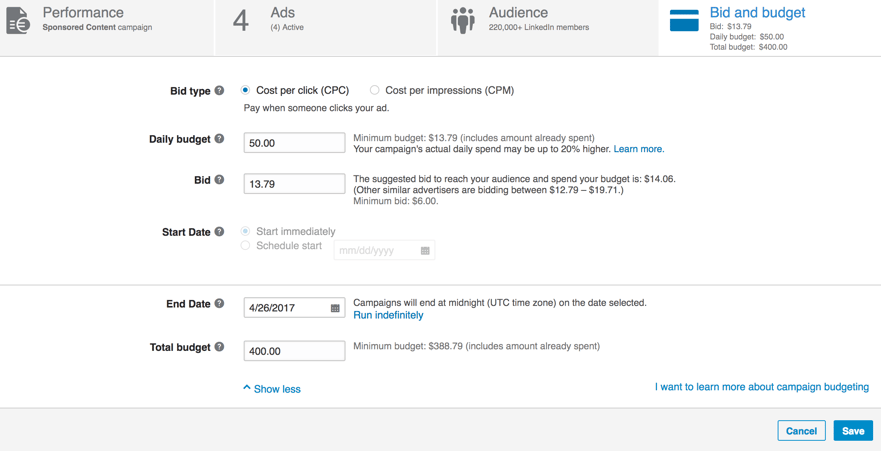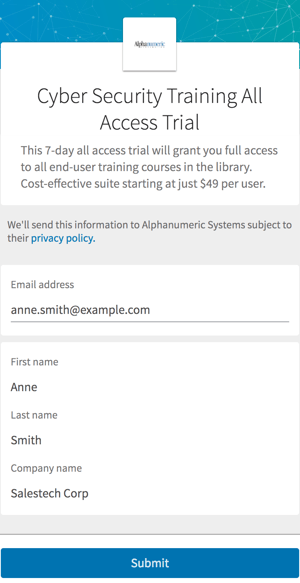According to LinkedIn, Lead Gen Forms are “a new solution that helps you drive even more high-quality leads from your Sponsored Content campaigns by removing the main barrier to mobile conversion: making someone complete a clunky contact form on a smartphone.” Many marketers are saying these user-friendly forms could be the answer to finally making LinkedIn advertising a force to be reckoned with, and with the results we’ve seen so far, our team certainly agrees.
The day after this new feature was launched we began testing the forms for our B2B clients and were pleasantly surprised by the results. As our campaigns have continued, we’ve noticed several factors that can quickly hinder or boost campaign performance. Below we’ve listed our top five “don’ts” and provided tips for how to maximize your campaigns.
1. Using Fields that Don’t Auto-Populate
With any campaign that involves a lead-capture form, it’s always important to keep form fields to a minimum. A cumbersome form can deter leads from filling it out, and the same holds true with LinkedIn Lead Gen forms. However, with these forms you must also go one step further -- only using fields that LinkedIn can auto-populate.
A huge part of the success of LinkedIn Lead Gen form campaigns is due the fact that LinkedIn will automatically populate user information into the form. If you require a field (or several) that the user needs to fill in manually, then your submission rate will drop.
First name, last name, and email are pre-selected when you create the form in Campaign Manager, but these can be removed and other options added. Common fields such as company, state or job title are typically safe to add because most users openly provide this information on LinkedIn, and so it will therefore populate automatically in your form. The trick is to not get greedy with information like work phone numbers. Any fields that the member does not have filled out on their LinkedIn profile will not pre-populate and will hurt your campaign performance.
2. Under Bidding Your CPC
While Lead Gen forms are new to LinkedIn, the bidding system is the same as it has been for Sponsored Updates, InMails, etc. LinkedIn’s auction-based bidding system means that having a higher bid helps the advertiser gain impressions, and thus clicks.
When you're on the final step of your campaign setup LinkedIn will show the minimum bid price for your target audience and provide a suggested bid based on how much other advertisers are bidding for the same audience. By bidding at or close to the suggested bid, you put your campaign in a more competitive position to win the bid and capture the audience.
There are however differing opinions in the marketing world with some claiming that the minimum is all you need to spend. For some less competitive audiences, this may hold true. However after countless LinkedIn campaigns and bid testing trials, our team consistently finds that a competitive bid will produce the best results.
3. Not Following Up with a Personal InMail
As of now, LinkedIn Lead Gen forms don’t have the capability to automatically send a follow up “thank you” email or LinkedIn message to users who submitted your form. Advertisers can currently only write a customized thank you message and send users to a website page.
We’ve chosen to then find the lead’s LinkedIn profile page by searching in Google for “Name, Company Name, LinkedIn” and 9 out of 10 times, the profile will pop right up. You can then connect with the lead to send a message or if you have LinkedIn Sales Navigator, send them an InMail message with a personal follow up.
Since the transaction was originally made on LinkedIn, this is the perfect place to follow up and continue the conversation so leads don’t go cold.

4. Not Searching for Company Email & Number
Taking the campaign a step further and beyond the LinkedIn platform, we’ve found that researching the lead on a prospecting platform is helpful when continuing the conversation as well.
Remember in the first tip where we mentioned only including fields that LinkedIn can auto-populate? This often means that the email address provided is a personal email, not a work email. Think about your LinkedIn account. Did you register with a personal or company email? We’ve found that about 90 percent of leads captured have provided their personal email address (since this autopopulates) instead of their company email.
However this is an easy problem to fix when you have access to a prospecting or similar paid platform that allows you to search for a person and find their company email address and direct line. This requires a bit more manual work on the advertisers part, but in the end this solution is the best of both worlds for the lead and advertiser.
5. Underutilizing Sales Team and CRM Followups
The final and most important step to see positive ROI is to involve your sales team in the campaign and fill their pipeline with these new sales-qualified leads. Look for integrations that will allow you to pipe these LinkedIn leads into your CRM platform, or manually add each lead and assign them to a salesperson.
Currently, our process is a follows:
- Lead submits Lead Gen Form
- Personal LinkedIn profile is researched
- Lead is sent follow-up LinkedIn message or InMail
- Prospecting tool is used to find company email and direct dial
- Lead is entered into CRM with all above information and any additional notes
- Lead is assigned to salesperson for further communications
In addition to your own A/B ad testing, audience optimizations and bid testing, these five steps will help ensure your LinkedIn Lead Gen form campaigns produce a high ROI.
April 25, 2017


